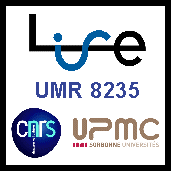Alternatives to endangered platinoid catalysts : sustainable earth-abundant elements in environmental electrochemistry applied to nanotechnology.
Résumé
One of the utmost concerns about water quality is related to the Nitrogen cycle imbalance, in part associated to anthropogenic nitrate (NO3-) pollution. Drinking water with elevated NO3- levels is harmful to human health. Nitrate pollution is one of the top ten water quality violations reported worldwide [1]. Fortunately, the electrocatalytic reduction of nitrate (ERN) appears as a user-friendly, chemical-free technology which avoids waste generation and that can selectively reduce NO3- to innocuous dinitrogen (N2). The scientific challenge is how to stop at a mid-point oxidation state, specifically N(0) rather than N(+III) or N(-III) as present in N2, NO2- or NH4+, respectively [2]. Fundamental research on ERN studied the electrocatalytic properties of noble metals and platinoid materials as cathodes. We recently identified these materials would be the cost driver of point-of-use treatment systems at household level. Moreover, considering life cycle analysis of the operational life of such endangered elements suggests that their use would be non-sustainable [3]. Therefore, the objective of this work is to catalyze the technology translation to higher technology readiness levels closer to commercialization through testing different alternative electrocatalysts based on earth-abundant elements and benchmarking them against the most typically reported platinum cathodes. We will present new data related to over 10 different electrode materials studied in parallel regarding electroreduction kinetics, selectivity towards nitrogen evolution, electrical energy per order and material availability. Copper, tin and carbon-based materials showed the highest electrokinetics reduction values with the lowest electrical energy per order when compared to other elements from the 4th period of the periodic table, competing with the traditional and endangered platinum catalyst. In fact, boron doped-diamond as carbon based electrode revealed to be a promising material, leading to the increase of the kinetics of nitrate removal about 1.5 times and selectivity towards nitrogen 6.0 times higher than with platinum. These encouraging results highlight the opportunity to apply earth abundant materials to nitrate removal. In addition, nanotechnology exploits untapped opportunities to enhance selectivity through facet nanoengineering. Use of nano-enabled electrodes for environmental remediation will enable catalytic sites that specifically tailor reduction of nitrate towards nitrogen, increasing as well the competitiveness of these systems.

